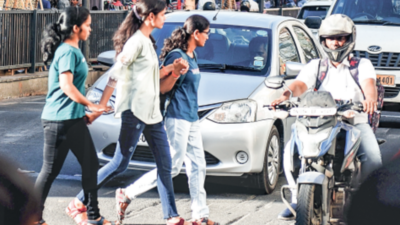Top Searches
- News
- City News
- chennai News
- Chennai has no room for its pedestrians
Chennai has no room for its pedestrians

In the last one year, 176 people died after being hit by vehicles in the city
Chennai : Shrinking walkways. A spike in cases of reckless driving. Chennai has sure become unsafe for pedestrians. In the last one year, 176 people died after being hit by vehicles across the city. Among them, 44% accidents were caused by two-wheelers. Metropolitan Transport Corporation (MTC) buses and private vans were habitual offenders in this aspect.
But the reduced carriageway width (due to metro rail, bridges and storm water drain work) has pushed light motor vehicles like cars to the shoulders, eventually forcing bikers to drive on pedestrian platforms.
Even the little space available for walkers are now encroached by unauthorised hawkers and commercial establishments such as hotels, textile shops, convenience stores and illegal bars. “This has put pedestrians at a higher risk. The corporation organises namesake eviction drives only after complaints, with no solution,” said K Senthil, a resident-activist from Porur.
An analysis of accident data by state agencies reveals that nearly half the number of pedestrian accidents have occurred on footpaths. Another 19% met with accidents while crossing the road at designated points. To curb this menace, Greater Chennai Traffic Police intensified its drive against signal jumping and stop line violations by booking 2,500 cases every month.
Despite this drive, violations continue. “It is high time for motorists to drive responsibly. Some of them violate the stop line and stop on the zebra crossing, leaving no place for the pedestrians to cross. They should ensure that they slow down at all junctions to ensure the pedestrians safety”, said Kapil Kumar C Saratkar, additional commissioner of police, GCTP.
Road traffic experts, however, has called for better coordination between state agencies to improve visibility of crossings, stop lines and reset traffic signals so that pedestrians have enough time to cross the roads. Apart from enforcement drives, the government needs to make policy changes to improve pedestrians’ safety by prioritizing them over motorists, said Aswathy Dilip, senior programme manager, Institute of Transportation and Development Policy (ITDP).
What state agencies mostly do is build foot-over-bridges (FOBs) at locations where pedestrian traffic is high. These bridges only help vehicles move quickly but put pedestrians at risk. “Though Chennai was the first metro to have a non-motorised vehicle policy, it is reflected only along GCC roads, while stretches maintained by highways department have narrow footpaths and inadequate crossing,” she said.
But the reduced carriageway width (due to metro rail, bridges and storm water drain work) has pushed light motor vehicles like cars to the shoulders, eventually forcing bikers to drive on pedestrian platforms.
Even the little space available for walkers are now encroached by unauthorised hawkers and commercial establishments such as hotels, textile shops, convenience stores and illegal bars. “This has put pedestrians at a higher risk. The corporation organises namesake eviction drives only after complaints, with no solution,” said K Senthil, a resident-activist from Porur.
An analysis of accident data by state agencies reveals that nearly half the number of pedestrian accidents have occurred on footpaths. Another 19% met with accidents while crossing the road at designated points. To curb this menace, Greater Chennai Traffic Police intensified its drive against signal jumping and stop line violations by booking 2,500 cases every month.
Despite this drive, violations continue. “It is high time for motorists to drive responsibly. Some of them violate the stop line and stop on the zebra crossing, leaving no place for the pedestrians to cross. They should ensure that they slow down at all junctions to ensure the pedestrians safety”, said Kapil Kumar C Saratkar, additional commissioner of police, GCTP.
Road traffic experts, however, has called for better coordination between state agencies to improve visibility of crossings, stop lines and reset traffic signals so that pedestrians have enough time to cross the roads. Apart from enforcement drives, the government needs to make policy changes to improve pedestrians’ safety by prioritizing them over motorists, said Aswathy Dilip, senior programme manager, Institute of Transportation and Development Policy (ITDP).
What state agencies mostly do is build foot-over-bridges (FOBs) at locations where pedestrian traffic is high. These bridges only help vehicles move quickly but put pedestrians at risk. “Though Chennai was the first metro to have a non-motorised vehicle policy, it is reflected only along GCC roads, while stretches maintained by highways department have narrow footpaths and inadequate crossing,” she said.
Start a Conversation
FOLLOW US ON SOCIAL MEDIA
FacebookTwitterInstagramKOO APPYOUTUBE









